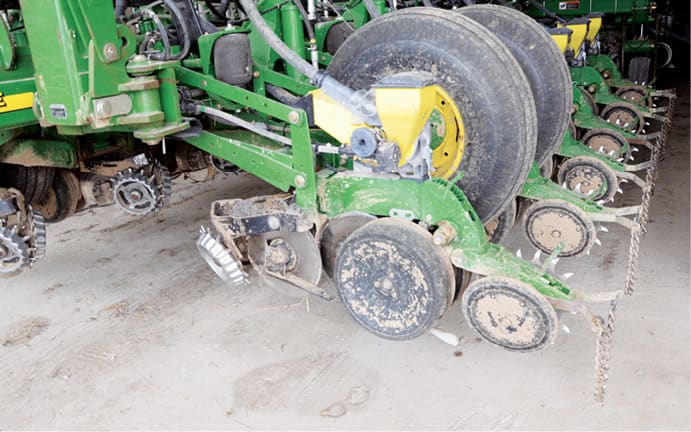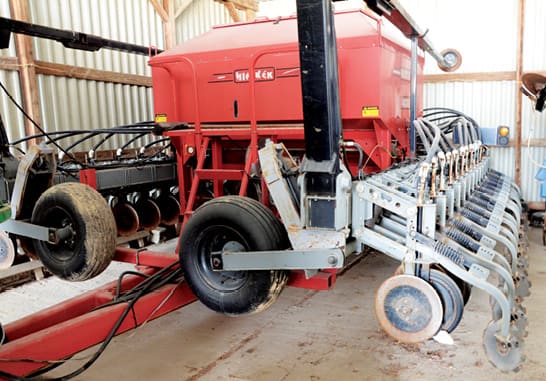Mark Legan and his family live by four core values: stewardship, relationships, integrity and continuous improvement.
The pursuit of these goals led Mark to adopt near 100% no-till and cover crop practices on their 1,000 acres of corn and soybeans near Coatesville, Ind., which is also farmed by his wife Phyllis and daughter and son-in-law Beth and Nick Tharp.
Mark believes combining these techniques with judicious management of manure produced by several thousand sows allows him to supply much of his farm ground’s needed fertility naturally while enhancing soil biological activity and organic matter.
The Legans’ farm received the American Soybean Association’s Conservation Legacy Award for the Northeast region in 2014.
Though Legan feels he’s settled on a powerful trifecta of manure application, cover crops and no-tilling, he doesn’t plan on dialing back experimentation and evolution. In the coming years, he sees himself becoming more of a manager than a tractor driver.
“A lot of what we do takes more management than conventional tillage,” says Legan. “But on our farm, we’re trying to emphasize the management aspect of farming and becoming better stewards of the land and resources,” he says.
Taming Tough Soils
Legan started no-tilling in 1983 on a small 60-acre plot to prove the concept to himself. Since then, he’s expanded the practice as his farm has grown. He’s transitioned to full no-tilling in the last 5 years, except for occasionally having to till up some of his substandard fields.
Legan says the silty clay loam soils they farm are somewhat poorly to poorly drained and he’s invested a lot of money in tiling the 600 acres he owns. And he’s worked with landowners to start installing tile on their land as well, but it’s been slow process. The lack of pattern tiling is one reason that prevented Legan from adopting no-till more widely in the first place.
“In this part of Indiana, the ground has to be tiled for no-till to even work,” he says. “Otherwise, these soils stay wet and cold and it’s pretty difficult to have a good crop.”
For example, Legan points to a recently acquired 100-acre field. Two years ago, he tiled half of it and the difference has been significant. Tile on most of Legan’s farm is on 60- to 80-foot spacing.
“Because of the timeliness of planting, as well as dealing with the drowned-out spots, there was a 20-bushel-per-acre increase in soybean yields the first year after we tiled it,” he says. “Tiling is a long-term investment, but that increase basically paid for a third of the cost of tiling in a single year. It’s often said around us that you pay for tiling on your farm whether you have it or not — in lost yield potential or cost of installation.”
You May Also Be Interested In...
Grazing for Soil Health and Getting Cover Crops Into the Mix
There’s never been a more important time to improve your soil health through grazing. This report is packed with powerful research from experts and filled with strategies for integrating livestock and cover crops to increase soil health.You can increase the health of your soil and cattle by implementing these practices backed by research and experience. Download now »
Healthier System
Over the past decade, Legan has seen a significant change in soil health and yields. While he partially credits favorable weather he believes no-till, cover cropping, manure applications and proper drainage have all contributed.
“I believe in a systems approach, rather than crediting one specific change I’ve made,” he says.
Anecdotally, Legan says he’s seen a significant surge in earthworm activity since switching to no-till and a more aggressive cover-cropping program. His own data shows a boost in organic matter, which is no easy task in his clay and timber soils.
“We’ve gone from around 1.5%-2% up to 2%-2.5% on most of our timber soils over the last decade. Some of the more poorly-drained soils are up around 3% or better,” he says.
As for yields, Legan has seen a 25- to 30-bushel increase farm-wide for corn over the same time period. In the last 5 years he’s averaged about 202 bushels of corn per acre, up from 175-180 bushels for corn from 2005-2010.
“I credit the weather a lot. But I think, at the very least, the changes we’ve made have helped weather-proof our soils,” Mark says. “During a drought in 2012, the county average for corn was 50 bushels per acre, but we raised 75 bushels. I think our strategies had something to do with that.”
Planter Procedure
Part of what drew Legan to no-tilling was the inherent efficiency of making the planter the most important piece of machinery on the farm.
“Manure has lots of micronutrients like copper, magnesium and sulfur. With most of those we’re getting in the ratios we need, but we test to make sure…”
Though he shared a planter with a neighbor for several years, he eventually invested in a 16-row John Deere 1770 planter with floating Martin row cleaners pulled by his Case IH tractor with OmniSTAR auto-steering.
He also has Martin fertilizer discs mounted on the row units in 2-by-2-inch configuration that applies 19-17-0 starter fertilizer with 5 pounds per acre of sulfur added for corn.
He’s made several valuable investments in precision equipment as well, including Precision Planting’s eSet meters and SeedSense technology for variable-rate seeding, along with an eDrive setup for singulation. Depending on soil quality, corn seeding rates vary from 28,000 per acre on clay or poorer soils to 34,000 on productive soils.
After variable-rating for 6 years, Legan says he’s saved about 10% on seed vs. using standard rate across all fields. Gauging the payoff on yield has been more difficult but he feels this technology has contributed to an increase of 10-15% over the last few years.
Differences in soil types also presents challenges for Legan when it comes to having proper down-force settings on his planter.
He uses Precision Planting’s AirForce technology on a custom 55-pound setting. “But depending, again, on the soil as we go across it will call for 100 to 200 pounds of pressure,” he says.
Managing Manure
Legan says he uses manure to supply about half of his corn’s total required nitrogen (N) and about half of the needed phosphorus (P) and potassium (K) on a yearly basis.
“We’ll put on manure one year and that has the nitrogen, phosphorus and potassium for that year’s corn,” he says. “Then generally, there’s enough phosphorus and potassium to carry over for the next year’s soybeans.”

Filling a need. After renting from a co-op for several years, Mark Legan invested in a 16-row John Deere 1770 planter for no-tilling corn. The machine is equipped with floating Martin row cleaners and Martin fertilizer discs in 2-by-2-inch configuration to apply 19-17-0 starter fertilizer with 5 pounds per acre of sulfur for corn. Several Precision Planting components were added for better seed singulation and depth control, as well as variable-rate planting.
The majority of manure is injected 6 inches deep, but he also applies some through irrigation using a two-stage lagoon and a center pivot that he irrigates out of the second stage onto a growing crop.
But the lagoon is only supplied by about 20% of his sows because keeping most of the manure in pits allows him to retain its nutrient value better, Legan says.
“When it goes to an open-air lagoon system, the N2 volatizes off and the phosphorus settles as sludge,” he adds.
Manure doesn’t provide a full nutrient profile itself, so Legan maintains a rigorous soil testing and manure-analysis system to look for blind spots and adjusts accordingly.
“Manure has lots of micronutrients like copper, magnesium and sulfur,” he says. “With most of those we’re getting in the ratios we need, but we test to make sure.
“For our permit, the state requires us to test manure every time we apply anyway. Occasionally, we’ll need to add extra sulfur in the starter fertilizer or by spreading some dry ammonium sulfate. We may be finding a way to add some extra magnesium soon, too.”
Through his consulting agronomist, Legan says each acre is soil tested every other year in 2- to 6-acre management zones.
To set his rates, Legan targets his desired amounts of N for a given crop — 100 pounds per acre of soybeans, which is allowed by the state on low-fertility ground, and 200 pounds for corn.
“On most of the corn ground we’ll use 8,000 gallons of manure to get us that 200 pounds of nitrogen,” he says. “One farm we just rented a few years ago is very low on fertility. By spreading 4,000 pounds of manure for soybeans, we’re able to get the 100 pounds of nitrogen we want — plus build up the P and K that we’re primarily after as well.”
However, Legan still has his agronomist pull a pre-sidedress soil nitrate test where manure was spread so he can make up for potential deficiencies while sidedressing 32% UAN.
Courting Cover Crops
Rolling out a dedicated cover cropping program has helped the Legans improve soils, but it’s taken awhile to find the ideal types and application methods. They’ve seeded covers off and on for 10 years but moved to applying them on almost 100% of their acres in the last 5 years.
Particularly, Legan feels cover crops have helped his fields retain the nutrients he spreads instead of having them wash from the field.

The right machine. Getting cover crops seeded in a timely manner has been a challenge at times for Mark Legan, so 3 years ago he bought a used Hiniker 4836 air seeder for the task and report good results overall. Currently he’s planting cereal rye at 15 pounds an acre after harvest, occasionally mixing in 2 pounds of rapeseed to add some diversity to the seeding.
“Manure is great for N, P and K, but there’s a lot of good micronutrients in there too, like sulfur, and a lot of organic matter,” he says. “When you talk about soil health and microbes, manure feeds the microbes.
“The idea of conserving the soil and keeping all those nutrients in place is really what drew me to cover crops in the first place.”
Legan has experimented with annual ryegrass, rapeseed, barley, radish and crimson clover in several variations, but has recently settled on cereal rye because he feels it’s the easiest to get established late season.
Though different types of crops added certain benefits, the need to be flexible often outstrips those considerations, he says. Finding an application method that works has also figured heavily into the equation.
“We’ve tried aerial applications and broadcast with a rolling harrow to incorporate. Three years ago, we bought an old Hiniker air seeder and we’ve been successful getting better stands out of that,” Mark says.
“We’re using about 15 pounds of cereal rye per acre now. We like annual ryegrass but we have better luck getting cereal rye established since we’re not always sure when we can plant. And it’s easier to kill in spring.”
On corn ground, Legan terminates covers as soon as possible in the spring, sometimes as early as March, but often in early April. He’s done some limited trials planting into a living cover crop, but still mostly prefers to burn down covers ahead of planting with 2,4-D mixed with glyphosate and a residual herbicide.
“We’re trying to terminate it early, because with cereal rye we’re concerned about the carbon-to-nitrogen ratio if the plants get too tall, and we don’t want to tie up the nitrogen that’s so important to corn,” he says.
If he’s planting green he’ll replace 2,4-D with Sharpen herbicide.
For some acres Legan adds about 2 pounds of rape with the rye to get some diversity in the mix. He’s pushed to get all cover crops seeded after harvest and reports the most establishment success with cereal and rape.
“With the rapeseed we’re really trying to tie up those nutrients, cut down on erosion and build soil structure,” he says. “It was easier to use radish when we were flying on the seed because we could get it done faster and see some early benefit. Now that we’re drilling it in we often don’t get into the field until late September or October.”








Post a comment
Report Abusive Comment